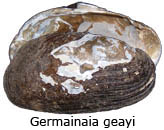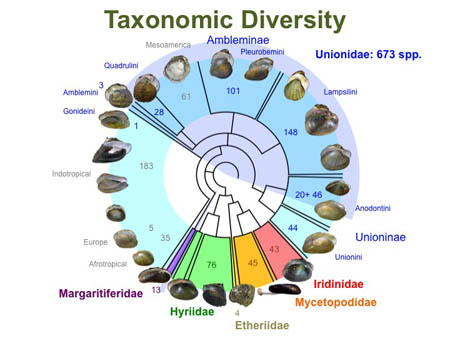| Page last updated
14 January 2014 |
2009 MUSSELp Publications & Presentations
Actual and alleged freshwater mussels (Mollusca: Bivalvia: Unionoida) from Madagascar and the Mascarenes, with description of a new genus, Germainaia
by Daniel L. Graf & Kevin S. Cummings
Published 2009, Proceedings of the Acadedmy of Natural Sciences of Philadelphia 158: 221-238. On BioOne.
 Abstract. Madagascar is widely recognized as a biodiversity hotspot, but the freshwater bivalves have received only limited recent attention. Based upon examination of records from 15 major museums and a literature review, at least nine species of freshwater mussels (Mollusca: Bivalvia: Unionoida) have been reported from either Madagascar or the Mascarene Islands (specifically, Reunion or Mauritius) in the Indian Ocean, east of Africa. The quality of the data, however, is generally poor. Seven of those species records are regarded as either erroneous reports of taxa known from other regions or as nomina dubia. No records from the Mascarenes are considered to be valid. The two remaining species, Etheria elliptica Lamarck 1807 and Unio geayi Germain 1911 (= Coelatura geayi) are both from Madagascar, and the latter is discussed in the context of two alternative hypotheses for the origin of the family Unionidae, nicknamed “Out of Africa” and “Into Africa.” Germainaia gen. nov. is introduced for Unio geayi to emphasize the distinction of that species from other Afrotropical freshwater mussel lineages. The possibility that Germainaia may represent the Hyriidae in Madagascar is discussed, but the new genus is left incertae sedis at the family-level in the absence of complete data. Abstract. Madagascar is widely recognized as a biodiversity hotspot, but the freshwater bivalves have received only limited recent attention. Based upon examination of records from 15 major museums and a literature review, at least nine species of freshwater mussels (Mollusca: Bivalvia: Unionoida) have been reported from either Madagascar or the Mascarene Islands (specifically, Reunion or Mauritius) in the Indian Ocean, east of Africa. The quality of the data, however, is generally poor. Seven of those species records are regarded as either erroneous reports of taxa known from other regions or as nomina dubia. No records from the Mascarenes are considered to be valid. The two remaining species, Etheria elliptica Lamarck 1807 and Unio geayi Germain 1911 (= Coelatura geayi) are both from Madagascar, and the latter is discussed in the context of two alternative hypotheses for the origin of the family Unionidae, nicknamed “Out of Africa” and “Into Africa.” Germainaia gen. nov. is introduced for Unio geayi to emphasize the distinction of that species from other Afrotropical freshwater mussel lineages. The possibility that Germainaia may represent the Hyriidae in Madagascar is discussed, but the new genus is left incertae sedis at the family-level in the absence of complete data.
Click here to see the web version of this publication.
Freshwater Mussel Studies in Zambia 2005-2008
by Daniel L. Graf, Kevin S. Cummings, & Alex D. Chilala
Poster presented at the Agricultural & Commercial Society of Zambia Show, 31 July-3 August 2009, Lusaka Zambia.
Abstract. The Republic of Zambia in Africa is biogeographically interesting because it includes the headwaters and substantial portions of both the Congo and Zambezi river basins. In 2005, 2007, and 2008, we sampled various localities for freshwater mussels (Mollusca: Bivalvia: Unionoida) from several localities around the eastern half of the country. In addition to our own fieldwork, we have examined the holdings of various research collections in the United States and Europe. To-date, our knowledge of the freshwater mussels of Zambia is based upon relatively few specimens. However, the material we have acquired thus far has been useful not only for substantiating the Pan-African distributions of the 24 species of the Upper Congo and Upper Zambezi basins but also for testing hypotheses of evolutionary relationships among the freshwater mussels of Africa, South America, and Eurasia.
(A printed copy of our poster is available from CafePress.com). Click here to view (or download) an enlarged jpeg of this poster. |
 |
There are about 300 species of freshwater mussels in North America. Is that a lot?
by Daniel L. Graf & Kevin S. Cummings
Presented to the Freshwater Mollusk Conservation Society, 19-23 April 2009, Baltimore, Maryland.
Abstract. It sure is. We have made an extensive re-evaluation of the secondary literature in order to describe the global diversity of freshwater mussels (Bivalvia: Unionoida). Using the MUSSEL Project Database, we assigned each species to one or more geographical regions (Nearctica, Neotropica, Afrotropica, Palearctica, Indotropica, and Australasia) and subregions, and each genus was assigned to the lowest possible taxonomic rank. Based upon our analysis, there are 842 Recent freshwater mussel species (in six families) worldwide, with 302 (36%) of them (in two families) found in North America. We will discuss the geographical and taxonomic diversity of freshwater mussels and place the North American assemblage into a global context. Our worldwide species checklist is available on the MUSSEL Project Web Site (http://www.mussel-project.net/) under the heading, Unionoida cum Grano Salis. This research was funded by grants from the National Science Foundation. |
 |
This slide shows the taxonomic diversity of freshwater mussel species by depicting a circular cladogram. The arc of each clade represents the relative proportion of the global diversity it occupies. Each family is color-coded, and the shaded purple wedges represent the North American portion. |
|
|